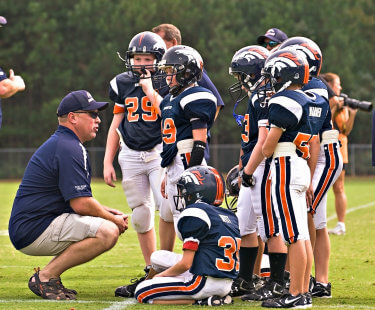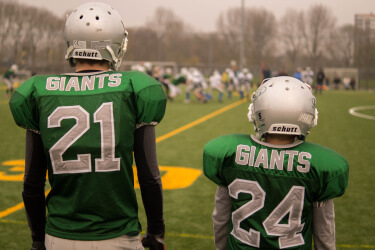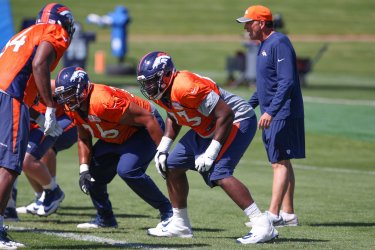Without question the most controversial subject in sports today is concussion risk and awareness. This is particularly true for youth sports. Lots of information is already in the mainstream regarding the effects of concussions, its direct sports related causes, and the preventive measures that are already in use and in development. For readers who are physical educators or coaches I imagine that you are already very familiar with this topic and knowledgeable about the effects and causes of sports related concussions. My commentary here will focus on my experiences and current opinions regarding the measures we are now seeing in sports.

Over my fifty plus years in sports, from my playing days and throughout my coaching and administrative years, I’ve witnessed concussions in several sports. As a high school basketball player I saw one of my teammates get undercut while rebounding and hitting the back of his head on the floor with a such huge boom that the packed crowd went deathly silent. When I was young basketball coach, one of my players collided with another player while going for a loose ball. Our player was immediately knocked out and suffered a short burst of convulsions while on the floor. As a soccer coach I witnessed the worst concussion incident in my entire career. One of our players, while going up into the air to head a ball backwards, collided heads with an opposing player trying to head the ball forward. Our player immediately went to the ground and began convulsing. It was a most horrible site indeed, but happily the player recovered nicely.
I coached football for more than twenty years and we likely had players receive concussions, but I really can’t recall one of our players experiencing a serious concussion. I strongly believe that the reason for this is that we taught both tackling and blocking with the shoulder and strongly urged players to keep their head up when tackling or making any kind of contact with opponents.
Earlier, as a college football player, I had been taught to lead with the face mask of my helmet and to aim for my opponent’s numbers on his chest. My chin doubled in size from the bruising I received from the crown of my teammates’ helmets hitting me in my chin during tackling drills. It was brutal indeed, but even worse was having the back of my head hit the ground because all tackling drills required taking the player to the ground. Not surprisingly, when I started coaching we mandated that our tackling drills not take the opponent to the ground, but instead drove him five yards back.

Seattle Seahawks Tackling and USA Football’s Heads Up Football
Rugby is similar to American football in that it entails full contact tackling. Even though rugby players wear no helmets, they suffer fewer concussions when compared to the problem we are seeing with American football today. In 2014, Coach Pete Carroll and the Seattle Seahawks instituted shoulder tackling using techniques rugby players taught them . The result was not just much better tackling, but a significant decrease in concussions due to this emphasis on safety. This was an extraordinary change in tackling technique at the highest level of American football. USA Football, an educational and promotional organization that aims at evolving and growing the sport of football by setting best practice standards for coaches and players, is today actively involved in teaching correct and safe techniques for youth football across the nation. Specifically, their Heads Up Football program is sweeping the country teaching a safer method of blocking and tackling that aims for a significant decrease in concussions. A major part of this program is the teaching of shoulder tackling with the head up.
One of the very last things I did as our school district’s director of athletics was host a Heads Up Football workshop for all of our coaches to get certified as Heads Up Coaches. Heads Up Football is a proven safety program that has as its first step to designate one of your school’s football coaches as the “Safety Coach.” This is an excellent start to making concussion safety a major point of emphasis.
Targeting in football
If you saw any college football games this year on TV, you likely saw the “Targeting” rule implemented with numerous playbacks of the incidents from every angle possible. You likewise probably saw many playbacks with helmet to helmet contact where the “Targeting” rule was not implemented. Without getting into the details of the rule itself, suffice it to say that the rule has been quite effective in eliminating the quantity of helmet to helmet contacts. Perhaps the best example of a bona fide effort to eliminate targeting is an instructional video produced by the Oregon School Activities Association for officials, coaches and players. This video is a standard for instructional videos on targeting.

However, unlike the “Facemask” and “Horse collar” rules, there is no penalty for every helmet to helmet contact. Presently, certain criteria must be met to invoke the “Targeting” rule. Although all helmet to helmet contact may never be eliminated, similar to way in which the “Facemask” and “Horse collar” rules are routinely called, it would behoove the NCAA and all of football to call “Targeting” whenever an official witnesses helmet to helmet contact. Such enforcement with no regard for specific criteria would, in my opinion, serve as an effective measure to increase safety, encourage coaches into teaching shoulder tackling, and decrease incidences of concussion in football.
The root cause of targeting incidents
For decades, football coaches have been using the opponent’s chest numbers as the initial aiming target when teaching tackling. I consider this the root cause of all targeting violations. When a player is taught and conditioned to aim for an opponent’s numbers on his chest, it follows that eventually the helmet—and specifically the crown of the helmet—is going to make contact with the opponent’s head and neck area. Even if one is teaching shoulder tackling but uses the numbers as the aiming point, contact with the head and neck area is inevitable. Coaches and administrators of football must look at this fundamental teaching point and consider making a dramatic change in how tackling is taught. The Seattle Seahawks instructional video on tackling is an excellent start.
